Welcome, Commander players! This primer is on the basics of playing Izzet in Commander, and it’s the second of a ten-part series that covers all of Magic’s two-color pairs. In this series, we’ll go through the strengths and weaknesses of each color pair, as well as common play styles. To get caught up, here is the first entry on Golgari.
Experimentation, exploration, and pushing the limits of what’s possible—that is the essence of Izzet. For these reasons, blue-red is one of Magic’s most beloved color pairs. Blue is the color of logic, knowledge, and trickery. Red is the color of freedom, passion, and impulse. When paired together, they touch the core of what makes many Magic players tick: the desire to explore what is possible within the scope of this game. For these reasons, you’ll see Izzet decks across all formats, and players happily slinging spells with islands and mountains.
Strengths
The “Noncreature Spells Matter” theme: Izzet has the benefit of being able to access a massive toolbox of noncreature spells. Additionally, cards like Goblin Electromancer and Etherium Sculptor help you cast them more efficiently. As an Izzet player, this helps fuel the spell-slinging engine that you construct in a game.

Cards like Redirect and Dualcaster Mage allow Izzet players to weave and manipulate their spells, or those from other players, to better suit the situation. While not all Izzet decks will lean heavily into this, it’s one of the most common playstyles for blue-red. This theme can generally be divided into two different families: decks that revolve around playing many instants and sorceries, and decks that rely on artifact synergies. Both families can be steered in a variety of directions.
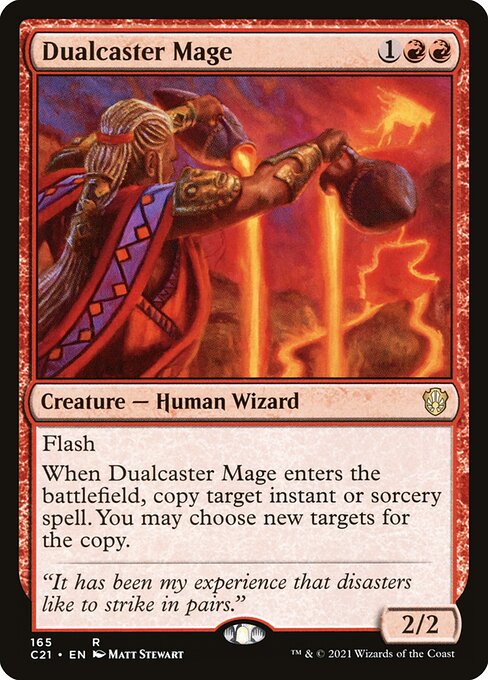
For decks playing lots of instants and sorceries, there are a variety of commanders and nonland permanents that encourage frequent spellcasting and card draw. This allows the strategy to grow into a couple of different directions. Izzet players are often motivated to be the player drawing the most cards, as well as the one casting the most spells. This leads to a pursuit of getting the most value possible out of the instants and sorceries that they cast. That extra value can come from different places, such as card draw off the back of Baral, Chief of Compliance, or being able to replay your spent cards with things like Past in Flames and Mizzix’s Mastery.
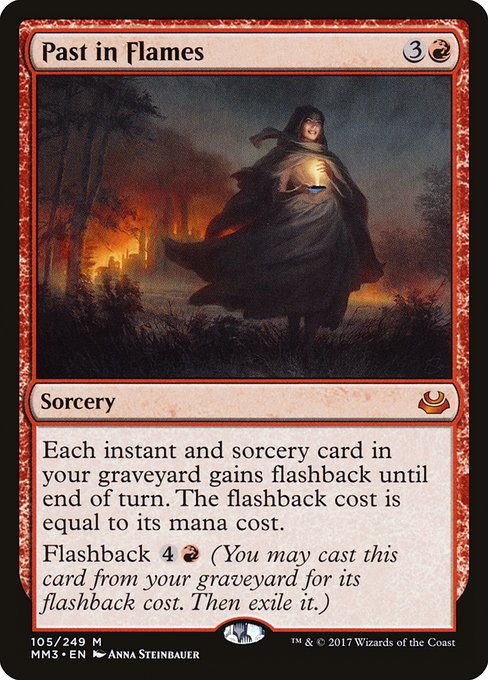
Like their Golgari counterparts, these strategies see the graveyard as a stopping point, but not the final destination. Recursion is something that Izzet does quite well—you can can read about the power of recursion here. By using a value engine like this, many Izzet players find success with archetypes like combo or control.
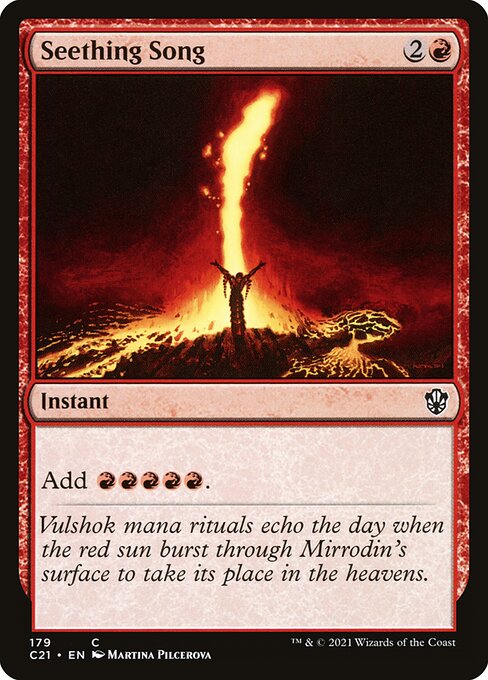
For instance, an Izzet combo player can chain multiple spells to power up an Aetherflux Reservoir, or to make a massive amount of drake tokens through Talrand, Sky Summoner. To get there, they’re using a variety of mana accelerant cards like Seething Song or Mana Geyser, and pairing them with cost-reducers and ways to draw cards while comboing off. Once they’ve cast enough cards out of their hand, and as many as possible for their graveyard, they’ll be digging for a payoff. These win conditions can sometimes come in the form of Mind’s Desire or Grapeshot: two iconic Storm cards.
However, this style of Storm deck is rather different from its monoblack counterpart. Monoblack Storm aims to generate a large amount of mana with various noncreature spells, and then use Ad Nauseam to draw through its library, which is riddled with low-cost cards, to find Tendrils of Agony. Whereas monoblack follows a more linear approach to reach its payoff, Izzet has more ways to maneuver and adapt its spells while opponents react to them on the stack.
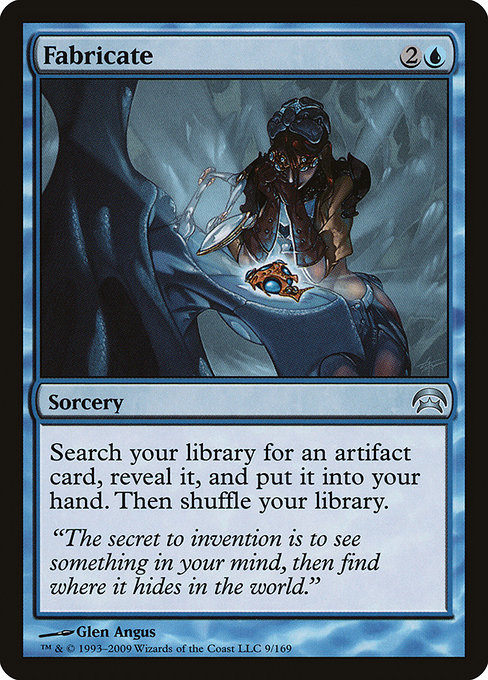
With artifact strategies, Izzet has a variety of powerful directions to go with. Blue has cards like Fabricate and Whir of Invention to find key pieces, whereas red can utilize Goblin Welder and Goblin Engineer to recur artifacts that get countered or removed. Pair this with a commander like Jhoira, Weatherlight Captain, and you have the foundation to explore the many ways that artifact decks can be built. There are far too many infinite combos to list, but these decks will frequently use a combo finish to close out the game. For a list of playable combos in the format, feel free to give this list a look.
Card draw: When playing Izzet, the question usually isn’t “Which card draw spells should I play?” but rather “Which ones should I cut?” Izzet has no trouble in finding a lot of card draw to choose from, and it comes stapled to every permanent type imaginable. And not only is there lots of card draw, but there are many different flavors that it comes in.
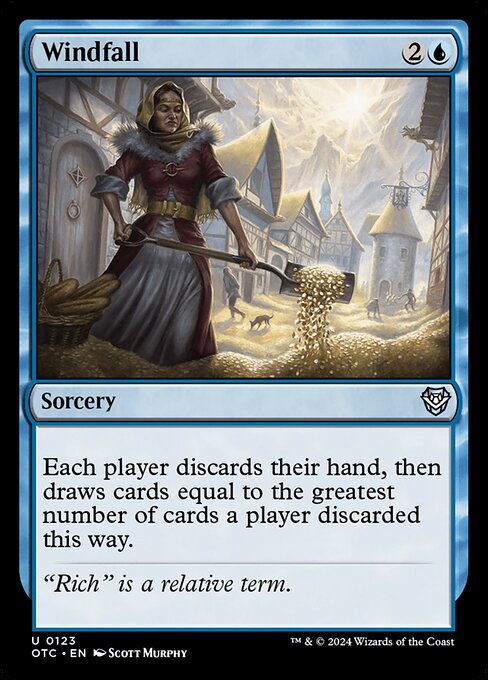
For decks that want a lot of cards in their graveyard, “wheel” effects like Reforge the Soul and Windfall offer ways to both refill your hand, and to start stacking your graveyard for later use. Powerful Delve spells like Dig Through Time and Treasure Cruise also see play, since they can be easily cast for one to two mana, respectfully. To add to this, Izzet has access to looting effects like Faithless Looting and Desolate Lighthouse, which can enable those graveyard strategies to flourish.
Board Wipes: Izzet has a variety of board wipes to choose from, but requires smart play to reach their highest potential. Blue offers mass bounce effects like Cyclonic Rift and Rebuild, whereas red offers creature sweepers like Blasphemous Act, artifact hate like Vandalblast, or even mass land destruction like Ruination.

The blue-based sweepers are often played at instant speed, and outside of Cyclonic Rift, they are symmetrical. That symmetry requires careful consideration of whether or not you can afford to bounce your own things at that moment. The ability to insert these spells anywhere on the stack makes them very flexible for game play, especially since you fire them off in a reactive nature, after you’ve received more information. The game state can change drastically after a sorcery-speed board wipe, and sometimes bigger threats show up after you’ve used that critical spell.
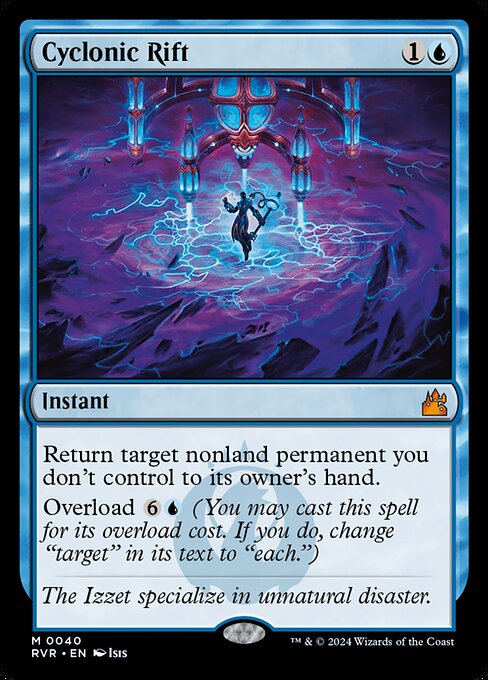
Hindsight is 20/20, of course. But, when in doubt, if that instant-speed sweeper is the thing that will set you up for victory on your turn, it’s advantageous to play it on the end step of the player whose turn happens right before yours. For games that go long, victory might hinge on being able to cast Cyclonic Rift from your graveyard. For your opponent playing a monowhite deck, that Wrath of God is pretty much as good as gone as soon as it hits their graveyard. However, thanks to the power of recursion in Izzet, it gives your board wipes added reach when compared to colors that can’t use their graveyard as much.
Weaknesses
Izzet is phenomenal for reacting and adapting to interactions in the game, due to the aforementioned tidbits. However, there are weaknesses to consider as well.

Ramp: Mana ramp is a fickle thing in Izzet decks. On one hand, you have spells like Seething Song and Desperate Ritual as fast mana, but it’s not a permanent ramp to your resources. However, those kinds of cards are generally used for accelerating into a combo, with the intention of ending the game on that turn. Izzet players can also get mana reduction effects through cards like Goblin Electromancer or Mizzix of the Izmagnus.
The value of these cards go up with the more spells you’re able to get out at a discount, but as with any creature-based mana effects, they’re prone to removal. As for things like mana-producing artifacts, results may vary. Izzet players aren’t necessarily better positioned to use these cards than other color pairs, but if built into an Izzet artifact deck, then there are more opportunities to exploit them for value. To summarize, Izzet is powerful for rapid bursts of mana acceleration, but fall short against decks that have access to green. It all depends on where you want your Izzet deck to go with its mana.

Single target removal: For Izzet decks, there’s quite a bit in this category, but it can fall short when compared to decks that have access to white, green, or black. Red is no stranger to blowing up artifacts, but usually needs damage-based removal to take out creatures and planeswalkers. Magmatic Sinkhole is a welcome addition in this category. As for blue, bounce effects are more common. However, Pongify and Rapid Hybridization are all-stars for taking out pesky creatures that you’d rather see become a 3/3. Reality Shift does a Path to Exile impression for this color pair, in spite of it costing an extra mana to cast. It’s not a direct replacement, but it can get the job done.

Outside of a dedicated hate card like Aura Flux, both colors have a lot of difficulty dealing with a resolved enchantment. But, the recent printing of Enchanter’s Bane gives some much-needed muscle to the fight against enchantments. When in doubt, Chaos Warp is powerful option for supplementing those shortcomings.
It’s important to remember that blue’s countermagic goes a long way. Counterspell becomes a catch-all for anything that you can’t easily deal with, so long as you deal with it before it resolves. In a way, countermagic can be compared to removal spells, with the big disclaimer that you’re forced to make a decision on whether or not to “remove” the opponent’s spell when priority passes to you.
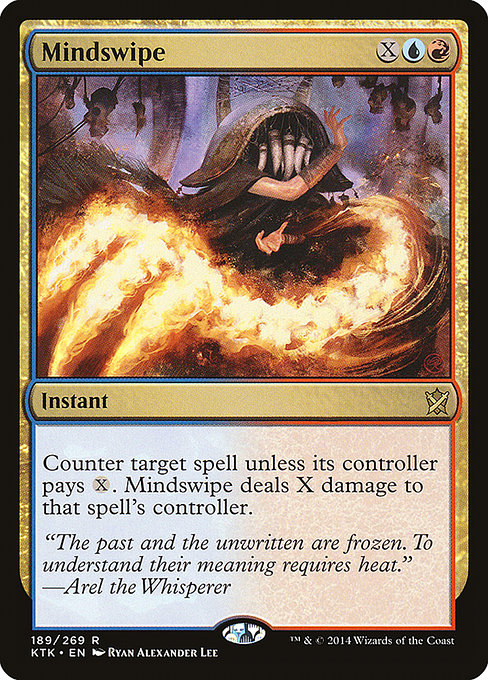
To dive into Izzet countermagic in particular, we gain access to things like Counterflux, Double Negative, and Mindswipe. Typically, the added red effects to an otherwise blue card will give it some extra flexibility on how to be played. Countermagic can be what an Izzet deck lives and dies on, so it is very beneficial for deckbuilders to pack at least a few for for their upcoming event.
Common Commanders and Archetypes
Spellslinger: Since Commander 2015 came out, Mizzix of the Izmagnus is one of the leading commanders for the “spells matter” theme. This is one part due to the cost reduction benefit that the goblin wizard brings, but also the resilience of experience counters that don’t go away when Mizzix gets sent back to the command zone.
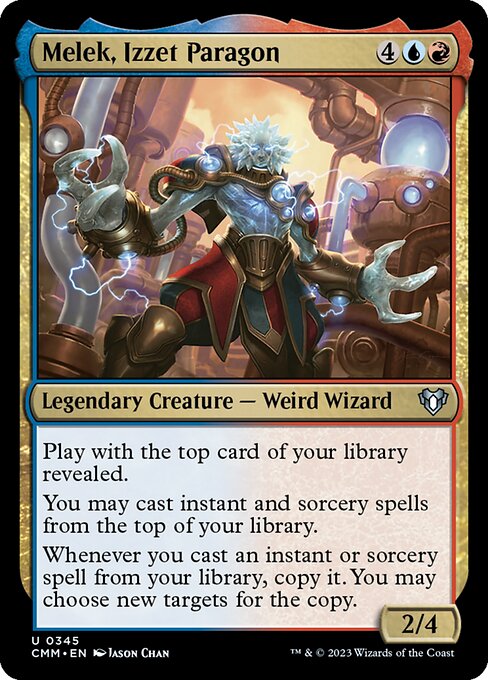
Jhoira of the Ghitu, usually centers around suspending splashy, big mana spells. Melek, Izzet Paragon is the BOGO sale of the spellslinger world, giving you two spells for the price of one. These are just a few examples of the multitude of options you have with spellslinger, and there are plenty more to dive into.
Card Draw Matters: These sorts of decks aim to draw as many cards as possible, and gain value off of permanents that care about card draw. They tend to include “Wheels” like Windfall and Reforge the Soul, but can also bake in incremental card draw like Faithless Looting.
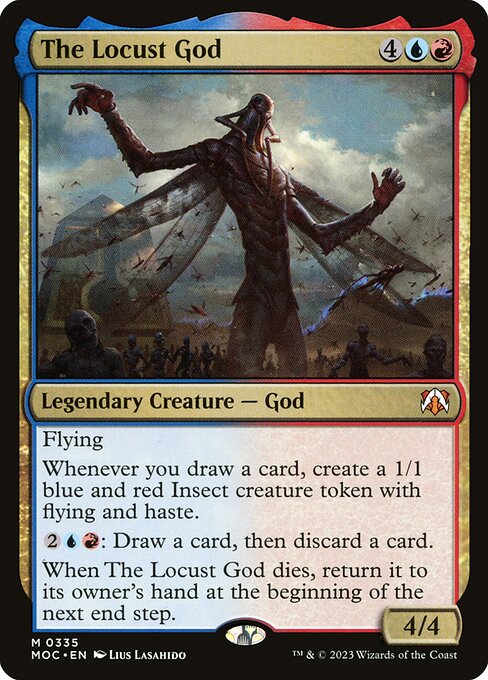
Niv-Mizzet, Parun is one such example of a commander here, although you could also easily build him into the aforementioned “spells matter” archetype. The Locust God is another mainstay of this play style, and will easily let you draw your deck if you land Kindred Discovery. Niv-Mizzet, The Firemind is a classic as well, and allows you to ping your opponents to death if you can attach a Curiosity on him.
Artifacts: For Izzet artifact decks, Jhoira, Weatherlight Captain is a breakout hit from Dominaria. She offers fantastic value for all of your historic spells, and acts as a great figurehead for a variety of artifact-based strategies. Saheeli, the Gifted offers the chance for some explosive turns with her second +1 ability. Tawnos, Urza’s Apprentice is for those of you that want to tinker with the many ways that triggered and activated abilities can be broken if copied.
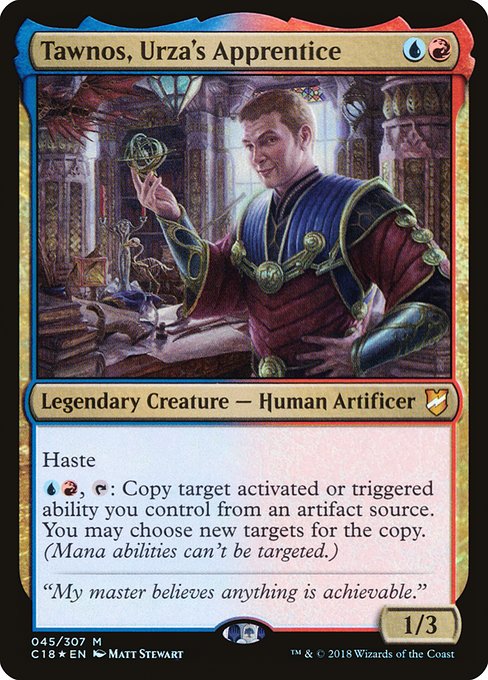
Other Oddities: Alongside these three established Izzet archetypes, there are also a variety of other oddballs to look into. For instance, Brudiclad, Telchor Engineer explores the concept of Izzet tokens, a space that Izzet hasn’t played a lot in before Commander 2018. The artificer also employs a variety of copying spells, allowing you to grow your token army at an alarming rate.

Nin, the Pain Artist is a favorite of Stuffy Doll fans, and can be built in a variety of ways to exploit her activated ability. Finally, Okaun, Eye of Chaos with Zndrsplt, Eye of Wisdom, is a recent pairing out of Battlebond, and wants you to flip as many coins as your heart desires.
Final Take
Izzet is a powerful color pair that can be built in a variety of directions, usually with a noncreature spell theme. It can be slow to build up sustainable mana sources, that can be used turn after turn, but it offers a lot of ways to interact with other players at instant speed. If you like drawing a ton of cards, or finding interesting combos to exploit, then Izzet is the pair for you.
Thanks for reading this edition of the guild primer; we’ll be back for more soon!
Travis is a Connecticut-based player and writer, who has been turning things sideways since Starter 1999. He primarily plays Commander, Pauper, and Modern, and has a passion for introducing new players to the game. When he isn’t attacking with red creatures, he can be found mountain biking or playing the guitar. You can follow his exploits here on Twitter and Instagram.

